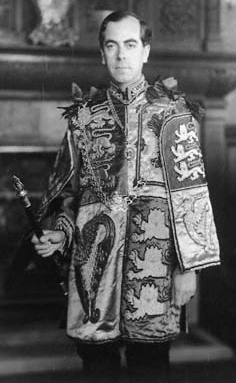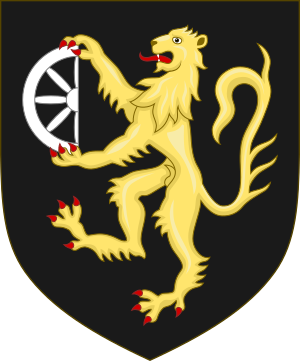Anthony Wagner facts for kids
Quick facts for kids
Sir Anthony Wagner
KCB KCVO FSA
|
|
|---|---|

Sir Anthony Richard Wagner, while serving as Richmond Herald of Arms in Ordinary in 1952.
|
|
| Garter Principal King of Arms | |
| In office 1961–1978 |
|
| Monarch | Elizabeth II |
| Preceded by | Sir George Bellew |
| Succeeded by | Colin Cole |
| Personal details | |
| Born | 6 September 1908 |
| Died | 5 May 1995 (aged 86) |
Sir Anthony Richard Wagner KCB KCVO FSA (6 September 1908 – 5 May 1995) was a long-serving officer of arms at the College of Arms in London. He served as Garter Principal King of Arms before retiring to the post of Clarenceux King of Arms. He was one of the most prolific authors on the subjects of heraldry and genealogy of the 20th century.
Contents
Early life and education
Wagner's distant ancestor, Melchior Wagner, arrived in England from the Saxon city of Coburg in 1709 and became hatter to George I and George II.
Wagner's father, Orlando Wagner, ran a day-school in London. He attended Eton College and Balliol College, Oxford, on scholarships. He found the classics uninteresting and graduated with a third in Literae humaniores. From early age he had been interested in genealogy and his favourite book as a boy was Hereford Brooke George's Genealogical Tables Illustrative of Modern History.
Professional career
Wagner joined the College of Arms as Portcullis Pursuivant of Arms in Ordinary in 1931. He was promoted to Richmond Herald of Arms in Ordinary in 1943 and Garter Principal King of Arms in 1961. In 1978 he retired to the subordinate position of Clarenceux King of Arms. Oxford University awarded him a DLitt and in 1979 he was appointed an honorary fellow of Balliol College.
He was a firm believer in the view that appointments to the college were for life. As a herald he enjoyed a very large practice and was able to train up a number of skilled and well-qualified assistants who later became officers of arms. His professional library was enormous, but he was also able to build up an important collection of early heraldic manuscripts from the Clumber and other sales.
During World War II he served in the War Office for four years, and then moved to the Ministry of Town and Country Planning, where he rose to be Principal Private Secretary to a series of ministers. Although he contemplated remaining in the Ministry, he returned to the College of Arms in 1946 and took over the extensive practice of Alfred Butler, Windsor Herald.
He took part in the Coronation of Queen Elizabeth ll in 1951 as Richmond Herald, and as Garter King of Arms took part in and was involved in the ceremonial aspects of the state funeral of Winston Churchill in 1965 and the Investiture of the Prince of Wales at Caernarfon Castle in 1969.
One idea, which he pursued persistently, was the establishment of a museum in which to display the treasures of the College of Arms itself. Initially it was hoped to erect a building adjacent to the college, and a design was commissioned from Raymond Erith; this became impossible because of the increasing financial demands of repairs to the college itself. But in 1981 the Heralds' Museum opened in part of the Tower of London.
He was elected a Fellow of the American Society of Genealogists in 1944.
In 1981 he defended the ceremonial aspects of British political life in an interview with Philip Howard of The Times: "Ceremonial induces a more reflective mood. It is an art form that embodies the continuity of the nation and the deposit of history. We live in a time of great change. But every item in a ceremonial like the coronation links us directly to the roots of our nationality more than 10 centuries ago". Howard said Wagner "is one of our most distinguished historians, the man who made heraldry respectable and who holds the sceptre of continuity in our changing times".
Chronology
- Appointed Portcullis Pursuivant of Arms in Ordinary (1931)
- General Editor, Dictionary of British Arms (1940–1995)
- Appointed Richmond Herald of Arms in Ordinary (1943)
- Secretary of the Order of the Garter (1952–1961)
- Registrar of the College of Arms (1953–1960)
- Joint Register of the Court of Chivalry (1954–1995)
- Appointed Garter Principal King of Arms (1961–1978)
- Knight Principal, Imperial Society of Knights Bachelor (1962–1983)
- Appointed Clarenceux King of Arms (1978–1995)
- Director, Heralds' Museum, Tower of London (1978–1983)
Other activities
Wagner had many interests outside the world and work of the College of Arms. He belonged to the Vintners' Company, serving as Master from 1973 to 1974; and was a member of a number of important dining clubs including the Society of Dilettanti, the antiquarian Cocked Hats, and the bibliophilic Roxburghe Club.
A number of large projects engaged his attention and enthusiasm. One, which arose from the Harleian Society, was an endeavour to list and describe the surviving English Rolls of Arms: to this series (CEMRA) Wagner contributed the first volume. Another project, connected with the Society of Antiquaries of London, was a revised edition of the ordinary of arms originally produced by J. W. Papworth. The first volume (of what was now entitled the Dictionary of British Arms) appeared in 1992.
Personal life
In 1953 (at the age of 44) Wagner married Gillian Graham, eldest daughter of Major H.A.R. Graham. In addition to taking over his father's house, 68 Chelsea Square, London, they acquired a country house in Aldeburgh, Suffolk. The couple had a daughter and two sons.
Wagner's funeral service was held at the Church of St Benet Paul's Wharf, the religious home of the College of Arms since 1555. The Queen was represented by Sir Conrad Swan. He was buried at Aldeburgh.
Honours
- Commander of the Royal Victorian Order (1953)
- Knight Commander of the Royal Victorian Order (1961)
- Knight Commander of the Order of the Bath (1978)
- Admiral, The Great Navy of the State of Nebraska, USA, (1987)
Arms
See also


